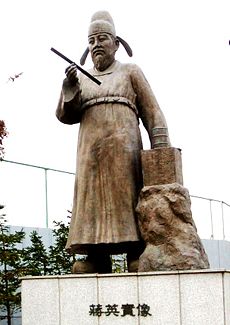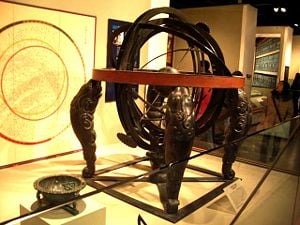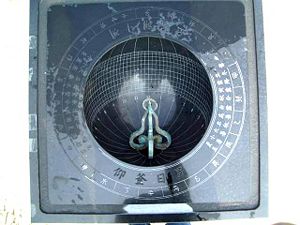Difference between revisions of "Jang Yeong-sil" - New World Encyclopedia
| Line 10: | Line 10: | ||
'''Jang Yeong-sil''' was a 15th century [[Korea]]n [[scientist]] and [[astronomer]] during the [[Joseon Dynasty]] (1392-1910). Although Jang was born into the slave or servant class of Cheonmin, [[King Sejong the Great|King Sejong]]'s new policy of breaking class barriers allowed Jang to be placed on the [[national civil service]] and to work at the royal palace. Jang's inventions, such as the [[rain gauge]] and the [[Irrigation#History of irrigation|water gauge]], highlight the technological advancements of the Joseon Dynasty. | '''Jang Yeong-sil''' was a 15th century [[Korea]]n [[scientist]] and [[astronomer]] during the [[Joseon Dynasty]] (1392-1910). Although Jang was born into the slave or servant class of Cheonmin, [[King Sejong the Great|King Sejong]]'s new policy of breaking class barriers allowed Jang to be placed on the [[national civil service]] and to work at the royal palace. Jang's inventions, such as the [[rain gauge]] and the [[Irrigation#History of irrigation|water gauge]], highlight the technological advancements of the Joseon Dynasty. | ||
| − | Asteroid 68719 is named in honor of Jang | + | Asteroid 68719 is named in honor of Jang Yeong-sil (http://wikipedia.org/wiki/Meanings_of asteroid_names_(68001-69000) and The Korean Ministry of Commerce and Industry awards an annual Jang Yeongsil prize. The Jang Young Sil Science High School is located in Busan and Sungkyunkwan University in Seoul offers an undergraduate Jang Young Sil Scholarship. http://www.skku.edu/eng/ The Celestial Globe invented by Jang appears on the back of each 10,000 won banknote. (Sookmyung Times http://translate.google.com/translate?hl=en&sl=ko&u=http://smtimes.sookmyung.ac.kr/news/articleView.html%3Fidxno%3D15&sa=X&oi=translate&resnum=2&ct=result&prev=/search%3Fq%3D%2522Jang%2Byoung%2Bsil%2522%2Bmoney%2Bwon%26hl%3Den%26rls%3Dcom.microsoft:en-us:IE-SearchBox%26rlz%3D1I7ADBR. |
==Early years== | ==Early years== | ||
| − | The date of Jang's birth is unknown, primarily due to Jang's status as a [[cheonmin|gwan-no]] | + | The date of Jang's birth is unknown, primarily due to Jang's low birth status as a [[cheonmin|gwan-no]].<ref>p. 17 Baek Seokgi. (1987). Woongjin Wi-in Jeon-gi #11 ''Jang Yeong-sil''. Woongjin Publishing.</ref> East Asian literature is inconclusive about the topic of Korean commoners.<ref>pg. 106 McKay Hill Buckler. (1999). ''A History of World Societies'', Fourth Edition. Houghton Mifflin Company, 222 Berkeley Street, Boston, MA 02116.</ref> At age 10, Jang was separated from his mother, a ''gwan-gi''.([[kisaeng]]), and he was sent to a civil court in [[Dongnae]]-hyeon <ref>p. 24 Baek Seokgi. (1987). Woongjin Wi-in Jeon-gi #11 ''Jang Yeong-sil''. Woongjin Publishing.</ref> There, he displayed talents in crafts and engineering by building machines to make the lives of his fellow workers easier. He also built aqueducts made out of bamboo shoots and canals for water irrigation,<ref>p. 37 Baek Seokgi. (1987). Woongjin Wi-in Jeon-gi #11 ''Jang Yeong-sil''. Woongjin Publishing.</ref> By floating a wooden dish upside down in the opening, he prevented spillage from jars during transit <ref>p. 27 Baek Seokgi. (1987). Woongjin Wi-in Jeon-gi #11 ''Jang Yeong-sil''. Woongjin Publishing.</ref> Jang also fixed instruments in disrepair.<ref>p. 30 Baek Sauk Gi. (1987). Woongjin Wi-in Jeon-gi #11 ''Jang Yeong-sil''. Woongjin Publishing.</ref> |
==National civil service== | ==National civil service== | ||
Revision as of 04:57, 17 October 2007
| Jang Yeong-sil | ||||||||
|---|---|---|---|---|---|---|---|---|
 | ||||||||
| Korean name | ||||||||
|
Jang Yeong-sil was a 15th century Korean scientist and astronomer during the Joseon Dynasty (1392-1910). Although Jang was born into the slave or servant class of Cheonmin, King Sejong's new policy of breaking class barriers allowed Jang to be placed on the national civil service and to work at the royal palace. Jang's inventions, such as the rain gauge and the water gauge, highlight the technological advancements of the Joseon Dynasty.
Asteroid 68719 is named in honor of Jang Yeong-sil (http://wikipedia.org/wiki/Meanings_of asteroid_names_(68001-69000) and The Korean Ministry of Commerce and Industry awards an annual Jang Yeongsil prize. The Jang Young Sil Science High School is located in Busan and Sungkyunkwan University in Seoul offers an undergraduate Jang Young Sil Scholarship. http://www.skku.edu/eng/ The Celestial Globe invented by Jang appears on the back of each 10,000 won banknote. (Sookmyung Times http://translate.google.com/translate?hl=en&sl=ko&u=http://smtimes.sookmyung.ac.kr/news/articleView.html%3Fidxno%3D15&sa=X&oi=translate&resnum=2&ct=result&prev=/search%3Fq%3D%2522Jang%2Byoung%2Bsil%2522%2Bmoney%2Bwon%26hl%3Den%26rls%3Dcom.microsoft:en-us:IE-SearchBox%26rlz%3D1I7ADBR.
Early years
The date of Jang's birth is unknown, primarily due to Jang's low birth status as a gwan-no.[1] East Asian literature is inconclusive about the topic of Korean commoners.[2] At age 10, Jang was separated from his mother, a gwan-gi.(kisaeng), and he was sent to a civil court in Dongnae-hyeon [3] There, he displayed talents in crafts and engineering by building machines to make the lives of his fellow workers easier. He also built aqueducts made out of bamboo shoots and canals for water irrigation,[4] By floating a wooden dish upside down in the opening, he prevented spillage from jars during transit [5] Jang also fixed instruments in disrepair.[6]
National civil service
King Sejong the Great instituted a policy of selecting officials based on their talent, not by their wealth nor social class. Jang's fame gained him entry into the royal court at Hanseong (present day Seoul), where selected commoners displayed their talents before the king and his advisers. Sejong saw that Jang met his expectations in crafts and engineering, and allowed Jang to work as a government official in the palace.[7] The talented scientists recruited under King Sejong's new program worked at the Hall of Worthies (집현전; 集賢殿; Jiphyeonjeon).[8]
Astronomical Instruments

Sejong's first assignment to Jang was to build a celestial globe to measure astronomical objects. Books obtained from Arabian and Chinese scholars were not complete in their instructions, for these devices could also be used for military purposes. After two months of study, he made a spherical device that could perform with mediocre accuracy. One year after his first attempt, in 1433, Young Sil made the honcheonui (혼천의, 渾天儀). Honcheonui depended on a waterwheel to rotate the internal globe to indicate time.[9] Whether day or night, this allowed the instrument to be updated on the positions of the sun, moon, and the stars.[10] Later celestial globes (i.e. gyupyo (규표)) could measure time changes according to the seasonal variations.[11] These instruments, along with the sundials and water clocks, were stationed around the Kyonghoeru Pond in Kyongbok Palace and made into use by the astrologers.[12] The success of Jang Yeong-sil's astronomical machines was marked in 1442 C.E. when the Korean astronomers compiled their computations on the courses of the seven heavenly objects (five visible planets, the sun, and moon) in Chiljeongsan (칠정산).[13]
Iron printing press
Although Chae Yun-ui (채윤의) invented the world's first metal printing press in 1234 during the Goryeo Dynasty, [12] Johann Gutenberg is recognized worldwide as the first to pioneer this technology. In general, metal movable type printing blocks surpassed the wooden counterparts in durability, clarity, and longevity.[14] Even then, the king asked the scientists at Jiphyeonjeon to build a better printing press. In 1434,[15] the scientists accomplished in building Gabinja (갑인자, 甲寅字),[16] which was made of copper-zinc and lead-tin alloys.[17] It was said to be twice as fast as the previous printing presses and print the Chinese characters in astounding beauty and clarity. Gabinja was reproduced six times during the next 370 years.[17]
Water clock
Self-striking water clocks had already been invented by the Arabians and the Chinese (in 1091),[18] and a more primitive form was in use by the Koreans. Although there is no archeological evidence, Samguk Sagi records that an office overlooking the use of water clocks had been established during the Three Kingdoms Period.[12] The Korean version consisted of two stacked jars of water, with water dropping from the top to the bottom at a measured rate. The level of the water indicated the time of the day. This was very inconvenient because a person had to be always be on guard, so that at each hour he or she could bang a drum to inform the public.
Upon hearing about the usage of self-striking water clocks in foreign countries, Sejong assigned Jang and other scientists to build a clock emulating such automatic devices. They failed in developing an operational water clock. Therefore, Jang went to China to study the various designs of water clocks. When he returned in 1434, Jang created Korea's first water clock, Jagyeokru (자격루).[19] This water clock did not survive; however, reconstructions of the Jagyeokru based on text descriptions have been made.
Circling the clock were 12 wooden figures that served as indicator of time. There were four water containers, 2 jars that received the water, and 12 arrows floating inside the lower container. As the water from the upper containers seeped down the pipe to the lower container, one of the arrows would tilt a board filled with small iron balls; a ball would roll down a pipe to a container of larger iron balls. The collision would cause the larger balls to travel down a lower pipe and hit a giant cymbal, announcing the time to the community. Then, the ball would land on another container, which is part of a complex of levers and pulleys that activates the motions of the wooden figures to indicate time visually.[20]
Sundial

Jang's invention of the water clock saw its infusion throughout the country. Yet, these were very costly, and the cheaper and more manageable alternative came about to be the sundial. Jang, Ichun, Kimjo, and other scientists made Korea's first sundial, Yangbu Ilgu (양부일구) (仰釜日晷),[21] which meant "pot-shaped sun clock staring at the sky".[22] Yangbu Ilgu was bronze in composition, and consisted of a bowl marked with 13 meters to indicate time and four legs jointed by a cross at the base.[22] 7 lines crossed the 13 meters in different curves to compensate for the seasonal changes of the course of the sun.[22] Yangbu Ilgu and other variants, such as the Hyunjoo Ilgu and the Chunpyung Ilgu, were implemented in strategic spots, such as the main streets with heavy traffic, so that the people could be well informed of the time. To compensate for the high illiteracy rate among the commoners, 12 shapes of animals, such as mouse, tiger, and cow, were engraved in juxtaposition with the meters.[22] No extant Choson Dynasty sundials today were made during King Sejong's reign, none known to have survived past Japanese invasions of Korea (1592-1598) (임진왜란).
Research on weaponry
From a discussion with the generals, Sejong learned that Korean melee weapons were duller and somewhat heavier than those of the neighboring countries; therefore, he sent Jang to Gyeongsang province, where he had spent his earlier life, to develop metal alloys for various weapons and tools. Since Jang used to be a gwan-no, he had already acquired much knowledge about metal working, and knew the geography of the area. Jang surveyed the available metals and their characteristics, and presented his research to king and the generals, contributing to the development of Korean weaponry.[23]
Rain gauge
Korean economy during the Choson Dynasty was agriculturally based, and its economy was vulnerable to elongated or consecutively occurring droughts. Therefore, there was need for ways to better manage water. Although rain gauges had been used in ancient Greece and India, Jang invented Korea's first rain gauge in 1441, called cheokugye (측우기),[24][25][26][27][28] and, by 1442, a standardized rain gauge with dimensions of 42.5 cm (height) and 17 cm (diameter) was introduced throughout the country to gather data on the yearly averages of precipitation throughout the different regions of the country.[8]
Water gauge
To allow better water management, the king asked the scientists to figure out some ways to inform the farmers of the available amount of water. And, in 1441, Jang invented the world's first water gauge, called Supyo (수표). It was a calibrated stone column placed in the middle of a body of water, connected by a stone bridge.[29]
Expulsion
Jang's extraordinary accomplishments earned him much trust of the king. Some government officials were very jealous of Jang, especially when he had achieved so much regardless of his common origin. Furthermore, as Korea's society was rooted in Confucianism, scientists and engineers were held in low esteem in parallel with craftsmen.
In 1442, King Sejong ordered Jang to build a gama, an elaborately decorated Korean sedan chair. The gama broke while the king was traveling, and Jang was held responsible. Although the king was against the decree, Jang was jailed for a long time, and was expelled from the royal palace. Later events of his life, including the date of his death, were not recorded.[30]
See also
- Printing
- King Sejong
- Joseon Dynasty
- Water Clock
- Sundial
- Hwacha
- Woo Jang-choon
ReferencesISBN links support NWE through referral fees
- ↑ p. 17 Baek Seokgi. (1987). Woongjin Wi-in Jeon-gi #11 Jang Yeong-sil. Woongjin Publishing.
- ↑ pg. 106 McKay Hill Buckler. (1999). A History of World Societies, Fourth Edition. Houghton Mifflin Company, 222 Berkeley Street, Boston, MA 02116.
- ↑ p. 24 Baek Seokgi. (1987). Woongjin Wi-in Jeon-gi #11 Jang Yeong-sil. Woongjin Publishing.
- ↑ p. 37 Baek Seokgi. (1987). Woongjin Wi-in Jeon-gi #11 Jang Yeong-sil. Woongjin Publishing.
- ↑ p. 27 Baek Seokgi. (1987). Woongjin Wi-in Jeon-gi #11 Jang Yeong-sil. Woongjin Publishing.
- ↑ p. 30 Baek Sauk Gi. (1987). Woongjin Wi-in Jeon-gi #11 Jang Yeong-sil. Woongjin Publishing.
- ↑ p. 46-49 Baek Seokgi. (1987). Woongjin Wi-in Jeon-gi #11 Jang Yeong-sil. Woongjin Publishing.
- ↑ 8.0 8.1 Korean History Project
- ↑ p. 55 Baek Seokgi. (1987). Woongjin Wi-in Jeon-gi #11 Jang Yeong-sil. Woongjin Publishing.
- ↑ p. 56 Baek Seokgi. (1987). Woongjin Wi-in Jeon-gi #11 Jang Yeong-sil. Woongjin Publishing.
- ↑ p. 77 Baek Seokgi. (1987). Woongjin Wi-in Jeon-gi #11 Jang Yeong-sil. Woongjin Publishing.
- ↑ 12.0 12.1 12.2 Indiana University Resources
- ↑ Introduction to the Folk Museum
- ↑ The Invention of Movable Type
- ↑ Glossary of Korean Studies
- ↑ p. 63 Baek Seokgi. (1987). Woongjin Wi-in Jeon-gi #11 Jang Yeong-sil. Woongjin Publishing.
- ↑ 17.0 17.1 Federation of Busan and Technology
- ↑ p. 68 Baek Seokgi. (1987). Woongjin Wi-in Jeon-gi #11 Jang Yeong-sil. Woongjin Publishing.
- ↑ p. 71 Baek Seokgi. (1987). Woongjin Wi-in Jeon-gi #11 Jang Yeong-sil. Woongjin Publishing.
- ↑ p. 72-73 Baek Seokgi. (1987). Woongjin Wi-in Jeon-gi #11 Jang Yeong-sil. Woongjin Publishing.
- ↑ p. 75 Baek Seokgi. (1987). Woongjin Wi-in Jeon-gi #11 Jang Yeong-sil Woongjin Publishing.
- ↑ 22.0 22.1 22.2 22.3 Kaeri Web Magzine
- ↑ p. 87-91 Baek Seokgi. (1987). Woongjin Wi-in Jeon-gi #11 Jang Yeong-sil. Woongjin Publishing.
- ↑ p. 97 Baek Seokgi. (1987). Woongjin Wi-in Jeon-gi #11 Jang Yeong-sil. Woongjin Publishing.
- ↑ Visit Busan Museum Guide
- ↑ American Meteorological Society press
- ↑ Education About Asia, Vol. 6, #2, Fall, 2001.
- ↑ Friendly Korea brief on Korean history
- ↑ p. 101 Baek Seokgi. (1987). Woongjin Wi-in Jeon-gi #11 Jang Yeong-sil. Woongjin Publishing.
- ↑ p. 108-111 Baek Seokgi. (1987). Woongjin Wi-in Jeon-gi #11 Jang Yeong-sil. Woongjin Publishing.
External links
- Newton Graphic Science Magazine, biography (in Korean)
- Youth Korea Times article (in Korean)
- Seoul National University profile (in Korean)
Credits
New World Encyclopedia writers and editors rewrote and completed the Wikipedia article in accordance with New World Encyclopedia standards. This article abides by terms of the Creative Commons CC-by-sa 3.0 License (CC-by-sa), which may be used and disseminated with proper attribution. Credit is due under the terms of this license that can reference both the New World Encyclopedia contributors and the selfless volunteer contributors of the Wikimedia Foundation. To cite this article click here for a list of acceptable citing formats.The history of earlier contributions by wikipedians is accessible to researchers here:
The history of this article since it was imported to New World Encyclopedia:
Note: Some restrictions may apply to use of individual images which are separately licensed.
